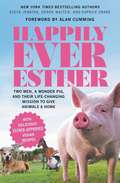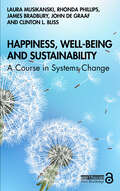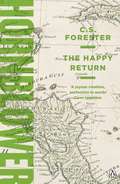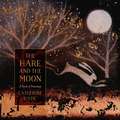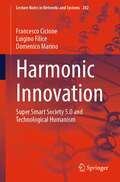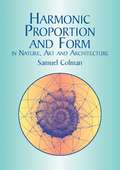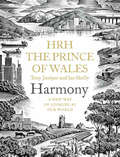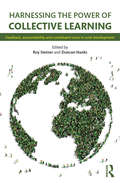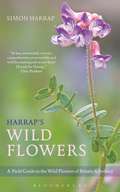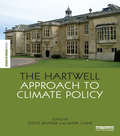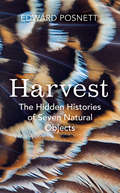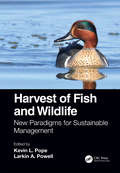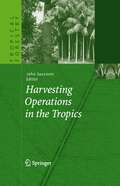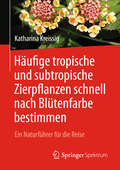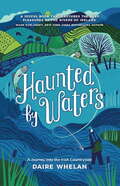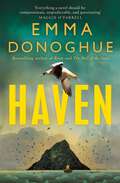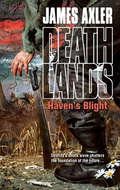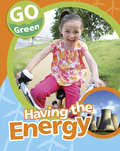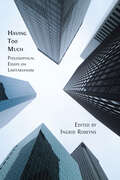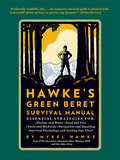- Table View
- List View
Happily Ever Esther: Two Men, a Wonder Pig, and Their Life-Changing Mission to Give Animals a Home
by Steve Jenkins Derek WalterFrom the New York Times bestselling authors and loving owners of Esther the Wonder Pig, comes a memoir about their new life on the Happily Ever Esther Farm Sanctuary, which is anything but boring. Steve Jenkins and Derek Walter, had their lives turned upside down when they adopted their pig-daughter Esther--the so-called micro pig who turned out to be a full-sized commercial pig growing to a whopping 600 pounds--as they describe in their bestselling memoir Esther the Wonder Pig. The book ends with them moving to a new farm, and starting a new wonderful life where they will live on the Happily Ever Esther Farm Sanctuary to care for other animals and just live happily ever after... Or so they thought. People often think about giving it all up and just moving to a farm. In theory it sure does sound great. But as Derek and Steve quickly realized, the realities of being a farmer--especially when you have never lived on a farm let alone outside of the city--can be frantic, crazy, and even insane. Not only are they adjusting to farm life and dutifully taking care of their pig-daughter Esther (who by the way lives in the master bedroom of their house), but before they knew it their sanctuary grew to as many as 42 animals, including: pigs, sheep, goats, rabbits, chickens, cows, roosters, a peacock, a duck, a horse, a donkey, and a barn cat named Willma Ferrell. Written with joy and humor, and filled with delicious Esther-approved recipes dispersed throughout the book, this charming memoir captures an emotional journey of one little family advocating for animals everywhere.
Happiness, Well-being and Sustainability: A Course in Systems Change
by Laura Musikanski Rhonda Phillips James Bradbury John de Graaf Clinton L. BlissHappiness, Well-being and Sustainability: A Course in Systems Change is the first textbook bridging the gap between personal happiness and sustainable social change. The book provides a guide for students to increase their skills, literacy and knowledge about connections between a sense of well-being and systems change. Further, it can help students live a life that brings them happiness and contributes to the well-being of others and the sustainability of our planet. The book is presented in seven chapters covering the subjects of systems thinking, personal and societal values, measuring happiness, human needs, ecological sustainability and public policy. In addition, each section includes engaging exercises to empower students to develop their own ideas, prompts for group discussion, suggestions for additional research and an extensive list of resources and references. The book is written in the context of systems thinking with a style that is approachable and accessible. Happiness, Well-being and Sustainability provides essential reading for students in courses on happiness, social change and sustainability studies, and provides a comprehensive framework for instructors looking to initiate courses in this field.
Happiness, Well-being and Sustainability: A Course in Systems Change
by Laura Musikanski Rhonda Phillips James Bradbury John de Graaf Clinton L. BlissHappiness, Well-being and Sustainability: A Course in Systems Change is the first textbook bridging the gap between personal happiness and sustainable social change. The book provides a guide for students to increase their skills, literacy and knowledge about connections between a sense of well-being and systems change. Further, it can help students live a life that brings them happiness and contributes to the well-being of others and the sustainability of our planet. The book is presented in seven chapters covering the subjects of systems thinking, personal and societal values, measuring happiness, human needs, ecological sustainability and public policy. In addition, each section includes engaging exercises to empower students to develop their own ideas, prompts for group discussion, suggestions for additional research and an extensive list of resources and references. The book is written in the context of systems thinking with a style that is approachable and accessible. Happiness, Well-being and Sustainability provides essential reading for students in courses on happiness, social change and sustainability studies, and provides a comprehensive framework for instructors looking to initiate courses in this field.
The Happy Return: Hornblower And The 'atropos'; The Happy Return; A Ship Of The Line (A Horatio Hornblower Tale of the Sea #6)
by C. S. ForesterJune, 1808 – and off the Coast of Nicaragua Captain Horatio Hornblower has his hands full … Now in command of HMS Lydia, a thirty-six-gun frigate, Hornblower has instructions to form an alliance against the Spanish colonies with a mad and messianic revolutionary, El Supremo; to find a water route across the Central American isthmus; and ‘to take, sink, burn or destroy’ the fifty-gun Spanish ship of the line Natividad – or face court-martial. And as if that wasn’t hard enough, Hornblower must also contend with the charms of an unwanted passenger: Lady Barbara Wellesley … This is the fifth of eleven books chronicling the adventures of C. S. Forester’s inimitable nautical hero, Horatio Hornblower.
The Hare and the Moon: A Calendar of Paintings
by Catherine HydeAn exquisite, full colour country almanac by artist Catherine Hyde, following the phases of the moon and a hare's journey throughout the twelve months of the year in a lyrical tribute to the natural world. Waking from the winter solstice a hare begins her journey. Through the landscape and its changing seasons, moving in harmony with the moon. Atmospheric and gorgeous paintings show the hare running in January, watching in February, leaping in March, until it comes full circle, sleeping in December. Twelve double page paintings of the hare's journey are accompanied by full pages of art, showing a tree, a flower and a bird for each month of the year. This rich celebration of flora, fauna and country life includes hawthorn and cowslips, swallows, blackbirds, buzzards and owls, harebells, holly, olive, rowan, poppies and much more. Titbits of text – folklore, fairytale, myth and legend complement the art complete this desirable gift book. This richly illustrated ebook is made in a fixed format layout to preserve the integrated text and colour images. Recommended devices that support this file include iPad, iPhone, Google Nexus and Kobo Arc. Please note that Fixed-layout ePUB 3 files are not currently supported on Amazon Kindle devices or B&N's NOOK.
Harmonic Innovation: Super Smart Society 5.0 and Technological Humanism (Lecture Notes in Networks and Systems #282)
by Domenico Marino Francesco Cicione Luigino FiliceThis book is aimed at researchers, entrepreneurs, and innovation consultants of the 5.0 era. For many centuries, the dominant paradigm of innovation was based on competition and the protection of the achievements (closed innovation).In the early years of the new millennium, the advent of globalization and the network has made the model evolve towards open and collaborative approaches (open innovation).Both methods corresponded to a different view of the world and society.Today, in a historical phase in which the world needs to become more sustainable and equitable, from the heart of the Mediterranean, the cradle of classical civilization, a group of valuable academics, scholars, and entrepreneurs propose to the world a new and further evolution of the concept of innovation and expression of the era we are living in: the harmonic innovation, an attempt to combine science and wisdom, technique and spirit, scientific research and moral research, technological progress and new humanism, new economy and social impacts, power, and limit.Anybody who aims to discover a fragment of future is welcome to read this book.
Harmonic Proportion and Form in Nature, Art and Architecture (General Science)
by Samuel ColmanA treatise on the laws governing proportional form in both nature and the arts and sciences, this well-illustrated volume amply demonstrates how a design's geometrical construction can captivate both the eye and the mind. Flowers, shells, and other natural organisms appear here, along with artistic creations, in a mathematical study of the similarity of their constructive principles. These principles, in turn, are the fundamental elements by which nature creates harmony.The author, Samuel Colman (1832–1920), was a prominent member of the Hudson River School of painters ("Storm King on the Hudson," his 1866 oil on canvas, is one of his best-known works), and an embodiment through his life and work of the school's celebration of nature through art. As an activist in the politics of art, Colman helped form the Society of American Artists as well as the American Society of Painters in Water Colors, a relatively new medium at the time. He was also a teacher and associate of Louis Comfort Tiffany; in 1879, the two joined forces to establish an interior design firm that included Mark Twain among its clientele.This handsome and provocative volume is enhanced by 302 drawings by the author that complement and amplify each subject area discussed. It also includes an important Mathematical Analysis by the editor, C. Arthur Coan. As a multifaceted study, this book will find an audience among artists and philosophers, as well as scientists and mathematicians.
Harmony: A New Way Of Looking At Our World
by H.R.H. Prince of Wales Tony Juniper Ian SkellyA practical guide to what we have lost in the modern world, why we have lost it and how easy it is to rediscover. Harmony is a blueprint for a more balanced, sustainable world that the human race must create to survive.
Harnessing the Power of Collective Learning: Feedback, accountability and constituent voice in rural development
by Roy Steiner Duncan HanksWhat were new ideas 30 years ago, such as the concepts of participatory development and systems thinking, are now accepted norms in international development circles. The majority of professionals engaged in rural development accept the proposition that the people who participate in development should play an active role in defining, implementing, and evaluating projects intended to improve their productivity and lives. However this goal remains unrealized in many development programs. Harnessing the Power of Collective Learning considers the challenges and potential of enabling collective learning in rural development initiatives. The book presents 11 case studies of organizations trying to develop and implement collective learning systems as an integral component of sustainable development practice. Through systematic reflection on action and experience, key lessons and themes emerge regarding the nature of voice, participation, feedback loops, accountability and transparency, that will be useful for many others in the development community. This book is a useful resource for academics, practitioners and policy makers in the areas of international development, sustainable development, organizational development, philanthropy, learning communities, monitoring and evaluation and rural development.
Harnessing the Power of Collective Learning: Feedback, accountability and constituent voice in rural development
by Roy Steiner Duncan HanksWhat were new ideas 30 years ago, such as the concepts of participatory development and systems thinking, are now accepted norms in international development circles. The majority of professionals engaged in rural development accept the proposition that the people who participate in development should play an active role in defining, implementing, and evaluating projects intended to improve their productivity and lives. However this goal remains unrealized in many development programs. Harnessing the Power of Collective Learning considers the challenges and potential of enabling collective learning in rural development initiatives. The book presents 11 case studies of organizations trying to develop and implement collective learning systems as an integral component of sustainable development practice. Through systematic reflection on action and experience, key lessons and themes emerge regarding the nature of voice, participation, feedback loops, accountability and transparency, that will be useful for many others in the development community. This book is a useful resource for academics, practitioners and policy makers in the areas of international development, sustainable development, organizational development, philanthropy, learning communities, monitoring and evaluation and rural development.
Harrap's Wild Flowers
by Simon HarrapWild flower identification may seem impossibly hard to those not familiar with them, but this brilliant new photographic guide aims to change that forever. With superb photography throughout, including stunning portraits and close-ups of key features where relevant, and succinct, no-nonsense text this ebook will help you identify almost any wild flower that you may encounter in Britain and Ireland. More than 800 carefully selected species are included in the guide, and only extreme rarities or seldom seen species are excluded. Key features are highlighted in tinted boxes throughout, and details of confusion species and look-alikes are given where relevant. Accurate colour maps based on the national plant-mapping scheme are provided for almost every species. This handy guide is an essential tool for anyone interested in our wild flowers.
Harrap's Wild Flowers
by Simon HarrapWild flower identification may seem impossibly hard to those not familiar with them, but this brilliant new photographic guide aims to change that forever. With superb photography throughout, including stunning portraits and close-ups of key features where relevant, and succinct, no-nonsense text this book will help you identify almost any wild flower that you may encounter in Britain and Ireland. More than 800 carefully selected species are included in the book, and only extreme rarities or seldom seen species are excluded. The pages have been designed to ensure that the photographs are reproduced at a sensible size and that the text is readable. Key features are highlighted in tinted boxes throughout the book, and details of confusion species and look-alikes are given where relevant. Accurate colour maps based on the national plant-mapping scheme are provided for almost every species. This handy guide is an essential tool for anyone interested in our wild flowers.
The Hartwell Approach to Climate Policy (The Earthscan Science in Society Series)
by Steve Rayner Mark CaineThe Hartwell Approach to Climate Policy presents a powerful critique of mainstream climate change policies and details a set of pragmatic alternatives based on the Hartwell Group’s collective writings from 1988-2010. Drawing on a rich history of heterodox but increasingly accepted views on climate change policy, this book brings together in a single volume a series of key, related texts that define the ‘Hartwell critique’ of conventional climate change policies and the ‘Hartwell approach’ to building more inclusive, pragmatic alternatives. This book tells of the story of how and why conventional climate policy has failed and, drawing from lessons learned, how it can be renovated. It does so by weaving together three strands of analysis. First, it highlights why the mainstream approach, as embodied by the Kyoto Protocol, has failed to produce real world reductions in greenhouse gas emissions and delayed real meaningful progress on climate change. Second, it explores the underlying political, economic, and technological factors which form the boundary conditions for climate change policy but which are often ignored by policy makers and advocates. Finally, it lays out a novel approach to climate change guided centrally by the goal of uplifting human dignity worldwide—and the recognition that this can only succeed if pursued pragmatically, economically, and with democratic legitimacy. With contributions from leading scholars in the field, this work presents a original critique of climate policy and a constructive primer for how to improve it.
The Hartwell Approach to Climate Policy (The Earthscan Science in Society Series)
by Steve Rayner Mark CaineThe Hartwell Approach to Climate Policy presents a powerful critique of mainstream climate change policies and details a set of pragmatic alternatives based on the Hartwell Group’s collective writings from 1988-2010. Drawing on a rich history of heterodox but increasingly accepted views on climate change policy, this book brings together in a single volume a series of key, related texts that define the ‘Hartwell critique’ of conventional climate change policies and the ‘Hartwell approach’ to building more inclusive, pragmatic alternatives. This book tells of the story of how and why conventional climate policy has failed and, drawing from lessons learned, how it can be renovated. It does so by weaving together three strands of analysis. First, it highlights why the mainstream approach, as embodied by the Kyoto Protocol, has failed to produce real world reductions in greenhouse gas emissions and delayed real meaningful progress on climate change. Second, it explores the underlying political, economic, and technological factors which form the boundary conditions for climate change policy but which are often ignored by policy makers and advocates. Finally, it lays out a novel approach to climate change guided centrally by the goal of uplifting human dignity worldwide—and the recognition that this can only succeed if pursued pragmatically, economically, and with democratic legitimacy. With contributions from leading scholars in the field, this work presents a original critique of climate policy and a constructive primer for how to improve it.
Harvest: The Hidden Histories of Seven Natural Objects
by Edward Posnett‘An exceptional first book; Harvest is a subtle, fascinating braiding of travel, cultural and natural history … It is a pleasure and an education to journey with him in these pages’ Robert MacfarlaneIn a centuries-old tradition, farmers in northwestern Iceland scour remote coastal plains for the down of nesting eider ducks.High inside a vast cave in Borneo, men perched atop rickety ladders collect swiftlets’ nests, a delicacy believed to be a cure for almost anything.Eiderdown and edible birds’ nests: both are luxury products, ultimately destined for the super-rich. To the rest of the world these materials are mere commodities but to the harvesters they are all imbued with myth, tradition, folklore and ritual, and form part of a shared identity and history.These objects are two of the seven natural wonders whose stories Harvest tells: eiderdown, vicuña wool, sea silk, vegetable ivory, civet coffee, guano and edible birds’ nests. Harvest follows their journey from the wildest parts of the planet, traversing Iceland, Indonesia, and Peru, to its urban centres, drawing on the voices of the gatherers, shearers and entrepreneurs who harvest, process and trade them.Blending interviews, history and travel writing, Harvest sets these human stories against our changing economic and ecological landscape. What do they tell us about capitalism, global market forces and overharvesting? How does a local micro-economy survive in a hyper-connected world?Harvest makes us see the world with wonder, curiosity and new concern. It is an original and magical new map of our world and its riches.
Harvest of Fish and Wildlife: New Paradigms for Sustainable Management
by Kevin L. PopeHarvest of Fish and Wildlife: New Paradigms for Sustainable Management unites experts in wildlife and fishery sciences for an interdisciplinary overview of harvest management. This book presents unique insights for embracing the complete social-ecological system to ensure a sustainable future. It educates users on evolutionary and population dynamics; social and political influences; hunter and angler behavior; decision processes; impacts of regulations; and stakeholder involvement. Features: Written by twenty-four teams of leading scientists and managers. Promotes transparent justification for fishing and hunting regulations. Provides examples for integrating decision making into management. Emphasizes creativity in management by integrating art and science. This book appeals to population biologists, evolutionary biologists and social scientists. It is a key resource for on-the-ground managers and research scientists developing harvesting applications. As the book’s contributors explain: “Making decisions that are robust to uncertainty…is a paradigm shift with a lot of potential to improve outcomes for fish and wildlife populations.” –Andrew Tyre and Brigitte Tenhumberg “Temporal shifts in system states…must somehow be anticipated and dealt with to derive harvest policies that remain optimal in the long term.” –Michael Conroy “Proactive, effective management of sportspersons…will be essential in the new paradigm of harvest management.” –Matthew Gruntorad and Christopher Chizinski
Harvest of Fish and Wildlife: New Paradigms for Sustainable Management
by Kevin L. Pope Larkin A. PowellHarvest of Fish and Wildlife: New Paradigms for Sustainable Management unites experts in wildlife and fishery sciences for an interdisciplinary overview of harvest management. This book presents unique insights for embracing the complete social-ecological system to ensure a sustainable future. It educates users on evolutionary and population dynamics; social and political influences; hunter and angler behavior; decision processes; impacts of regulations; and stakeholder involvement. Features: Written by twenty-four teams of leading scientists and managers. Promotes transparent justification for fishing and hunting regulations. Provides examples for integrating decision making into management. Emphasizes creativity in management by integrating art and science. This book appeals to population biologists, evolutionary biologists and social scientists. It is a key resource for on-the-ground managers and research scientists developing harvesting applications. As the book’s contributors explain: “Making decisions that are robust to uncertainty…is a paradigm shift with a lot of potential to improve outcomes for fish and wildlife populations.” –Andrew Tyre and Brigitte Tenhumberg “Temporal shifts in system states…must somehow be anticipated and dealt with to derive harvest policies that remain optimal in the long term.” –Michael Conroy “Proactive, effective management of sportspersons…will be essential in the new paradigm of harvest management.” –Matthew Gruntorad and Christopher Chizinski
Harvesting Operations in the Tropics (Tropical Forestry)
by John SessionsThis book brings together information on harvest methods, system productivity, and methods for conducting safe, efficient, and environmentally acceptable operations in tropical forests. It highlights the challenges of harvest operations in the tropics, includes techniques that have been shown to be successful, and discusses newer technologies. Numerical examples are provided to provide clarity for interpreting graphs, procedures, and formulas.
Häufige tropische und subtropische Zierpflanzen schnell nach Blütenfarbe bestimmen: Ein Naturführer für die Reise
by Katharina KreissigDieses Buch ist eine praktische, kompakte Anleitung zur Bestimmung von häufig vorkommenden tropischen und subtropischen Zierpflanzen anhand der Blütenfarbe. Es richtet sich an alle, die sich für Pflanzen interessieren und auf Reisen gern die attraktiven Blütenpflanzen warmer Regionen näher kennenlernen möchten. Sicher hat jeder in einem fremden Land schon einmal eine besonders exotische Blüte bewundert und sich gewünscht zu wissen, um welche Pflanze es sich handelt. Anhand von ansprechenden Fotos und verständlichen Texten liefert dieses Buch einfach und schnell die Antwort. Die Autorin ist eine erfahrene Reiseleiterin und wird unterwegs regelmäßig nach auffälligen Zierpflanzen gefragt. Sie hat die häufig nachgefragten Pflanzen fotografiert und in diesem Naturführer nach Farben gegliedert zusammengestellt. Dieses Buch ist durch seine Bebilderung und einfache Sortierung auch für Einsteiger ohne botanische Vorkenntnisse geeignet.
Haunted by Waters: A Journey into the Irish Countryside
by Daire WhelanAward-winning producer and journalist Daire Whelan had reached the end of another busy week and couldn't shake the feeling that life was passing him by too quickly. Vowing to make a change, he decided to commit to a year of fly fishing and set about planning his route through the wild and rugged landscape of Ireland. Here, in Haunted by Waters: A Journey into the Irish Countryside we travel with Daire throughout a season of fly fishing. But as he searches for a sense of meaning, meeting kindred spirits as he explores the rivers and lakes, Daire finds himself rediscovering the majestic beauty of his native country. From fishing on our most secluded bays and wildest loughs in Connemara and Kerry, to casting a line on the rippling waters of the Suir in Tipperary, catching salmon on the Blackwater in Waterford, and the serenity of the Dodder in Dublin on a workday afternoon, Haunted by Waters is an evocative and stunning love letter to Ireland through a sport rich in tradition and storytelling.
Haven: From the Sunday Times bestselling author of Room
by Emma DonoghueThe hugely anticipated novel from the internationally bestselling author of The Pull of the Stars and Room'Haven is everything a novel should be: compassionate, unpredictable, and questioning. This is Donoghue at her strange, unsettling best.' - Maggie O'Farrell, author of Hamnet'Combines pressure-cooker intensity and radical isolation, to stunning effect.' – Margaret Atwood via TwitterThree men vow to leave the world behind them and start anew . . . In seventh-century Ireland, a scholar and priest called Artt has a dream telling him to leave the sinful world behind. Taking two monks – young Trian and old Cormac – he travels down the river Shannon in search of an isolated spot on which to found a monastery. Drifting out into the Atlantic, the three men find an impossibly steep, bare island inhabited by tens of thousands of birds, and claim it for God. Their extraordinary landing spot is now known as Skellig Michael. But in such a place, far from all other humanity, what will survival mean?Haunting, moving and vividly told, Haven displays Emma Donoghue’s trademark world-building and psychological intensity – but this tale is like nothing she has ever written before . . .
Haven's Blight
by James AxlerThe future rose from the ashes of nuke-scorched America with a vengeance. The unchecked wrath of Deathlands pits Ryan Cawdor and his companions against long odds.
Having The Energy: Having The Energy (Go Green #1)
by Helen Lanz'Go Green: Having the Energy' looks at what energy is, how we use - and waste - it every day, and how this is contributing to global climate change. It explores how we can all reduce our energy use by taking small individual steps that add up to a big saving.Packed with statistics, useful information and handy tips, each title in the tells us what steps we can all take to `go green`.
Having Too Much: (pdf)
by Ingrid RobeynsHaving Too Much is the first academic volume devoted to limitarianism: the idea that the use of economic or ecosystem resources should not exceed certain limits. This concept has deep roots in economic and political thought. One can find similar statements of such limits in thinkers such as Plato, Aquinas, and Spinoza. But Having Too Much is the first time in contemporary political philosophy that limitarianism is explored at length and in detail. Bringing together in one place the best writing from key theorists of limitarianism, this book is an essential contribution to political philosophy in general, and theories of distributive justice in particular. Including some of the key published articles as well as new chapters, Having Too Much is necessary reading for scholars and students of political theory and philosophy, as well as anyone interested in questions of distributive justice.
Hawke's Green Beret Survival Manual: Essential Strategies For: Shelter and Water, Food and Fire, Tools and Medicine, Navigation and Signa
by Mykel HawkeThe perfect home-reference book for both seasoned outdoorsmen and average citizens to learn comprehensive outdoor survival techniques.This practical survival guide from U.S. Special Forces Captain and outdoor survival expert Mykel Hawke includes illustrated instruction on:shelter and waterfood and firetools and medicinenavigation and signalingsurvival psychologyHawke's engaging style and matter-of-fact attitude-not to mention his incredible resume in the survival arena-elevates this book above its competition.
